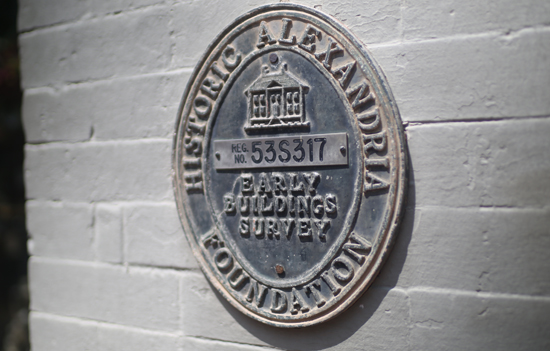Ever wondered why there are cast iron stars on buildings in Old Town Alexandria? Or what the fire marks on our historic rowhouses mean? This weekend you can get a glimpse inside these old homes on the Alexandria Historic Homes & Garden Tour, featuring original interiors and spring flowers adorning walled gardens. But Old Town’s historic buildings are also fascinating from the outside! To help you decipher Old Town Alexandria architectural embellishments, here are the stories behind the stars, fire marks and more:
Fire Marks
 Image credit: BCF for Visit Alexandria
Image credit: BCF for Visit Alexandria
You can spot these fire marks or plaques on several Old Town homes, including on Fairfax Street near the Stabler-Leadbeater Apothecary Museum, where you’ll find three different designs featuring an eagle, a tree and a boy with a torch. Rumor has it that the fire marks indicated the homeowner had fire insurance and was eligible to have fires put out by the fire brigade. That is only partially true, however. According to NPR, fire marks were not a requirement for insured properties. They simply served as advertisements for the insurance companies and possibly to deter arson. (If you want to know more about these historic plaques, visit the Friendship Firehouse Museum in Old Town.)
Star Anchors

Image credit: Visit Alexandria
They may look purely decorative, but the metal stars—or star anchors—on homes throughout Old Town are actually the end pieces of wrought-iron bars that support the gable walls of masonry structures, holding the walls to the home interior and preventing them from buckling. Head to the corner of Pitt and Cameron streets to see a great example.
The Historic Alexandria Foundation Early Building Survey Plaques
 Image credit: BCF for Visit Alexandria
Image credit: BCF for Visit Alexandria
When the Historic Alexandria Foundation first started issuing these plaques in the 1970s, they were awarded to houses based on age alone. Today, the HAF awards these plaques to houses that are at least 100 years old and meet the HAF definition of “architectural integrity.” That may sound easy, but proving a house is at least 100 years old is no simple matter. To apply for the plaque, a homeowner must document the age of the house using a combination of records (like titles, tax records, wills, etc.). If a homeowner can prove the house is 100 years old or more, then an architect or architectural historian determines if it retains “architectural integrity,” e.g., true divided light windows, operating shutters, no artificial materials and a whole host of other details. Finally, if the house meets the standards, the homeowner pays a fee and receives the plaque.
The Pineapple Motif
 Image credit: Flickr user Heather
Image credit: Flickr user Heather
Maybe you’ve picked up on the stone or metal pineapples adorning homes and gardens around Old Town, or even seen a real one atop the Port City Brewing Co. sign at the brewery. According to local historians, these imported fruits were rare and expensive for colonial families, so sharing a pineapple was a generous gesture of hospitality. Eventually the pineapple became a common symbol of hospitality in Virginia and elsewhere.
Gas Lamps
 Image credit: Ben Fink for Visit Alexandria
Image credit: Ben Fink for Visit Alexandria
Old Town Alexandria retains many of its gas lamps, the remnants of the old 19th century gas lighting system. Eventually electric lighting replaced gas—a costly and often unsafe form of lighting—but the lamps themselves have become an Old Town Alexandria signature.
Decorative Door Knockers
 Image credit: BCF for Visit Alexandria
Image credit: BCF for Visit Alexandria
From lions to eagles and (you guessed it) pineapples, you’ll find quite a few photo-worthy door knockers in Old Town. As a symbol of wealth in the city’s earlier days, the more ornate a door knocker, the more affluent the homeowner. Head to N. Royal Street off King Street to see some intricate examples.
Alexandria’s got all kinds of architectural ornamentation, from wrought iron to snow birds (used to keep snow from falling off a roof) and decorated weathervanes (like the one on the Friendship Firehouse). Next time you’re in Old Town, see how many you can spot!
To learn more about Old Town Alexandria architecture, click here.
Thanks to Wellington Watts and his team of local history experts for their help with this blog post.
Header image credit: BCF for Visit Alexandria






